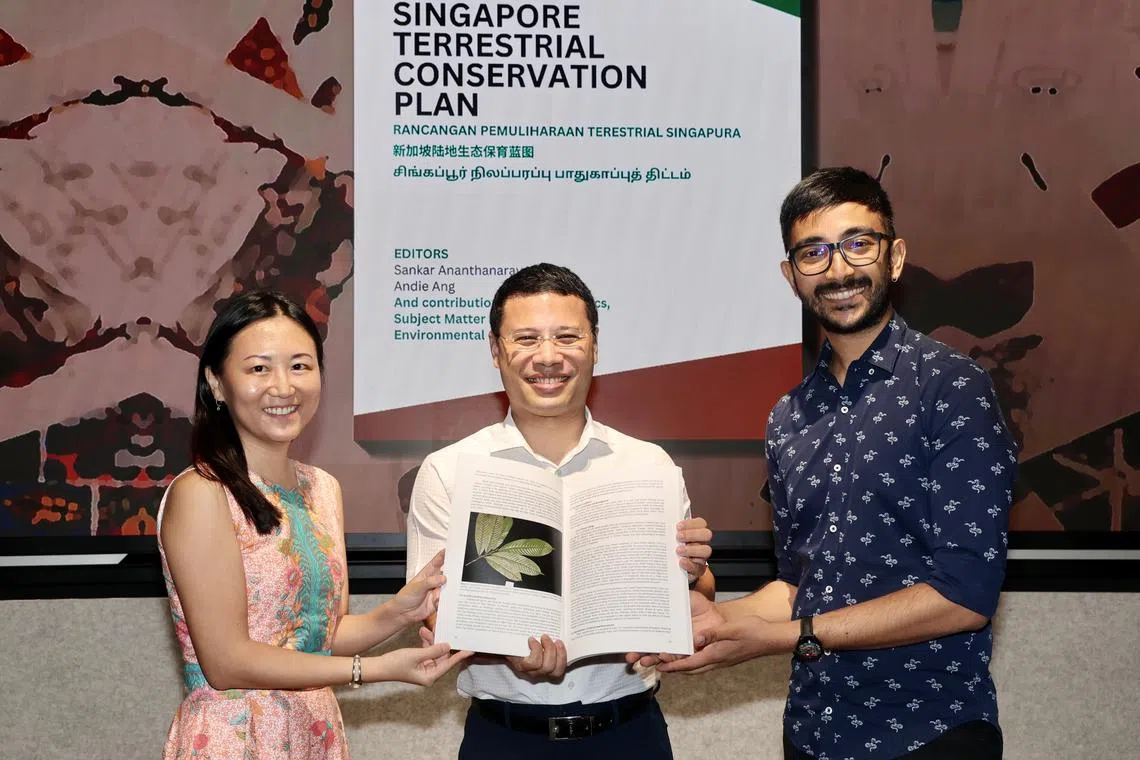Govt to study suggestions from conservationists to further protect S’pore’s nature: Desmond Lee
Sign up now: Get ST's newsletters delivered to your inbox

National Development Minister Desmond Lee (centre) with primatologist Andie Ang (left) and Herpetological Society of Singapore co-founder Sankar Ananthanarayanan.
PHOTO: LIANHE ZAOBAO
Follow topic:
SINGAPORE – The Government will carefully study recommendations to protect nature here by nearly 40 conservationists and local scientists, said Minister for National Development Desmond Lee.
These suggestions include studying the protection of Mandai and Tagore forests
Mr Lee, who is also Minister-in-charge of Social Services Integration, was speaking on April 28 at the Central Public Library at the launch of the Singapore Terrestrial Conservation Plan, a book that maps the state of biodiversity here and consolidates the aspirations of the nature community.
He said: “The passion and support of the community remain the cornerstone of nature conservation in Singapore.”
Mr Lee outlined previous collaborations between the Government and nature advocates, like the gazetting of Sungei Buloh – a haven for migratory shorebirds
The 171-page book, helmed by Herpetological Society of Singapore co-founder Sankar Ananthanarayanan and primatologist Andie Ang, took about three years to compile. It is based on discussions with nature advocates, including academics from the National University of Singapore and Nanyang Technological University.
Mr Sankar said: “One of the main priorities (in Singapore) right now is... to recover a lot of the species that are rare or even lost in Singapore.”
These include the critically endangered Raffles’ banded langur, a native leaf-eating monkey that can be found only in Singapore and Malaysia. The Tagore forest, one of its habitats, is slated for housing at the moment.
Since the birth of a baby of the species in the past few months,
“What many of the authors have called attention to is that we should also be focusing on re-establishing functional ecosystems, not just the species but also the processes that take place inside the ecosystem,” added Mr Sankar.
Recognising the competing uses for sites in land-scarce Singapore, he and Dr Ang noted that there needs to be a deeper understanding of all biodiversity and the spaces to know how best to protect them.
These include forested land controlled by the Defence Ministry like the Mandai and Tagore forests, as well as the Western Catchment forest.
Said Mr Sankar: “I think what is important to recognise is that there is biodiversity value in spaces that are not protected for biodiversity reasons.
“The Western Catchment forest is not protected for its biodiversity value, but it has intrinsic value; the problem is that we don’t fully understand it.”
Also among the book’s recommendations is the years-long call for environmental impact assessments to be enshrined in law, a concern that was aired in Parliament in March.
Currently, there is no legislation that states when such assessments are required for a proposed project, when they are discretionary and when they are not needed.
Said Dr Ang, who heads Mandai Nature’s primate conservation and Singapore programmes: “With that law, it can help to ensure that there is improved consistency, transparency and accountability for development.”
Going forward, the goal is to update the book in about five to 10 years.
Said Dr Ang: “It is meant to be outdated, because it is out there so that we can encourage more research to make it outdated.”
The book can be read for free at this website.
Recommendations of the Singapore Terrestrial Conservation Plan
Protect remaining habitats, and restore and rehabilitate degraded habitats like Bukit Brown
Enhance terrestrial and aquatic ecological connectivity
Understand and mitigate human impact on habitats and species
Intensify research into biodiversity, ecology and conservation to better inform priority-setting
Allow research in restricted sites including the Western Catchment forest
Codify environmental impact assessment into law
Establish legal boundaries of protected nature areas, and enhance enforcement of laws, especially Parks and Trees Act and Wildlife Act
Mainstream nature education in all aspects of Singaporean society
Increase data sharing and transparency among agencies and non-governmental stakeholders


